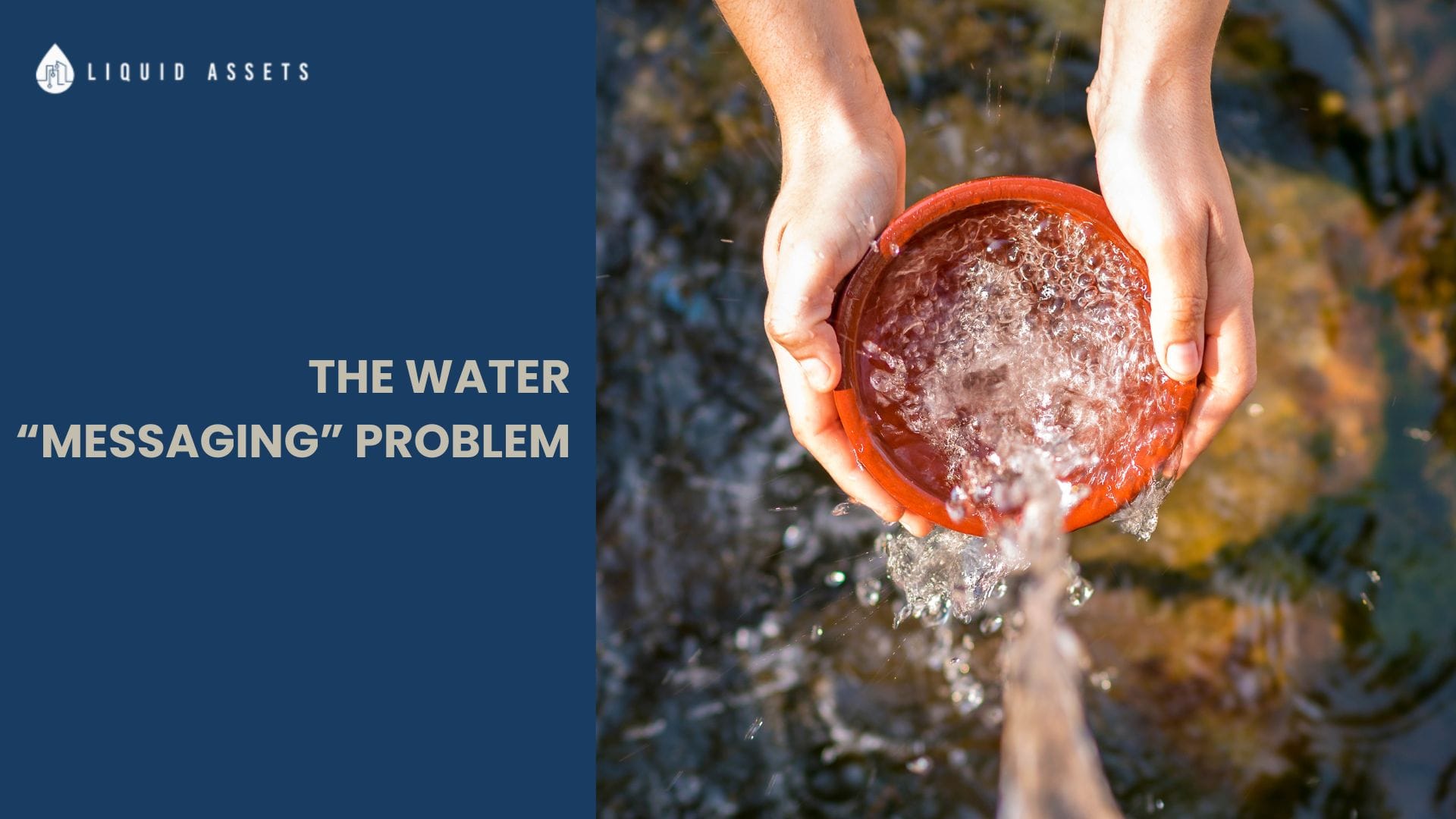How Water Organizations Can Alleviate the Water Messaging Problem

Clear communication is a make-or-break issue for water utilities and agencies hoping to earn customer trust, support and keep the entire world interested in matters related to "Water". Yet, little is being talked about water, and even when water is being talked about, the complex language and jargon often overwhelm ratepayers, voters, homeowners, and farmers on issues impacting water affordability, infrastructure projects, conservation initiatives, and more.
In this article, we analyze the core messaging challenges in the water sector and provide research-backed solutions to simplify communication, improve transparency, boost engagement, and rebuild customer trust through empathy.
The Problems with Water Messaging: Complexity, Jargon and Information Gaps
Water management encompasses profoundly complex systems for sourcing, treating, testing, and distributing this life-essential resource. The intricacy can be difficult to convey without insider terminology and data dumps that leave average customers confused and disengaged.
This communications gap has real impacts on water policy and public health. We see it in crises like the 2022 Jackson, Mississippi water failure where residents struggled to understand technical explanations during disruptions that left tens of thousands of homes dry for weeks.
Information gaps also enable misinformation to spread quickly via social media, as occurred in the 2021 Texas power grid failure which impacted water services. The past decade shows mounting infrastructure risks from aging pipes to contamination by chemicals called PFAS. Yet the public often lacks context to weigh the importance of upgrade projects on ballot measures because communication fails to connect infrastructure investment to real-life impacts like safer household water.

Customer Trust Hinges on Simplified, Audience-Focused Communication
The tons of research and expert interview we've done here on Liquid Assets indicates customer trust ranks among the most significant challenges named by water organization leaders when polling the sector’s top issues. Yet few rank communications strategy as a top priority for overcoming the trust deficit.
This represents a key opportunity - and imperative - for water agencies to transform messaging approaches with the customer’s point of view front and center. In such scenarios, the path forward lies greatly in simplifying language, enhancing visual engagement, proactively sharing information online and via social channels, and utilizing storytelling to make connections more relatable to daily life.
Even when technical jargons are eliminated when talking about water, what becomes even more important is how everyone views water and its importance. People hardly think about what is happening in the water sector, the policies taking place and the business at the forefront of improving the future sustainability of water, and this is why Simplified Audience-Focused communication for the masses must be employed and also ingrained into the everyday life of everyone be it social media, prints, in the education system on TV and even debates on water!
Expert Take On "Messaging" In Water
We've had the privilege of participating in discussions on "Liquid Assets: The Business of Water," hosted by Ravi Kurani, where we engaged with a diverse array of water experts. This esteemed group included entrepreneurs, esteemed professors, dedicated activists, and influential policymakers, all of whom shared insights on the messaging challenges surrounding water-related issues in various contexts. Here are a few:

"It's amazingly tough because if you show up at a water system and you say, we can help you address your water problem, what you've inherently said is, you have a water problem. And what they don't want to hear is that they have water problems." _ Seyi Fabode
It suggests that there is a need for sensitive and effective communication strategies when interacting with these systems. Therefore, an effective approach would be to frame the conversation in a manner that does not directly imply that the system has problems, but rather focuses on optimization, efficiency, or some other positive outcome. This way, the focus shifts from the negative aspect of having a problem to the positive aspect of improving the system. This approach might lead to a more receptive audience and a higher likelihood of cooperation in implementing solutions.
You can find our full episode conversation with Seyi Fabode on The Intersection of AI and Water: Insights from Varuna CEO Seyi Fabode episode.

So all of a sudden, when we come in and say, "hey, we want to recycle wastewater in your building and put it back up in your pipes", that understandably touches on that yuck factor that we talked about earlier. And so I think everything that we do as a company is just really speaking simply, not using a lot of jargon. And I think there's a lot of interesting science just in terms of the words that you use. And so I think, again, this is a whole area that we as a company are really fascinated by; the Science Communication, the science of language to get people comfortable with a topic like water._ Aaron Tartakovsky
Aaron of Epic Cleantec in this quote, is discussing the challenges his company faces when presenting their water recycling technology to clients. Their technology involves recycling wastewater in buildings for non-drinking purposes which, as he mentions, can often instigate a 'yuck factor' for individuals not familiar with the concept. In essence, Aaron is discussing the need for effective science communication, acknowledging that the language they use has a significant impact on people's comfort and acceptance of their wastewater recycling technology. This indicates their commitment to making water recycling more approachable and understood by the public.
You can find our full conversation with Aaron Tartakovsky in Turning Wastewater Into Gold - Catalyzing A Water Reuse Revolution episode on Liquid Assets.

You got to understand your customer and if you understand your customer then it makes it very easy to match your products or your solutions with what they're looking for. So, really, the whole thing about messaging goes back to understanding your customer and what the challenges are and do your homework to communicate this well. _ Chris Golden, CWT
Chris believes that thorough research and preparation are necessary to gain understanding and to thoroughly communicate with water stakeholders and users. This could involve studying the customer's industry, business model, history, and other relevant factors. With that knowledge, one can craft a message that resonates with the customer, addressing their unique challenges and demonstrating how the offered solution can help overcome them.
In essence, Chris Golden's take on the messaging problem is that effective communication is not just about crafting a compelling narrative, but about ensuring that the narrative is meticulously tailored to the customer's specific context and needs. This approach enhances the likelihood of the message being well-received and the solution being accepted.
You can find our full conversation with Chris Golden, CWT of Taylor Water Technologies LLC in Understanding the Landscape of Industrial Water Sales episode on Liquid Assets.

But we find that because water is a need day in and day out, and we take it for granted, if we're living here in the US, that it becomes kind of taken for granted in the philanthropic conversation as well. Not to mention, I mean, it's really interesting to learn all of the conversations in business around water usage and water scarcity and climate change. As I go to conferences or talk to different partners about water, we're not even speaking the same language to ourselves. Those of us working in water and sanitation and health are always talking about it a certain way. I go to a conference where businesses are meeting about this, they're talking about volumetric accounting, they're talking about all of these other things, social co benefits, which I imagine we can find a through line, too. But even amongst ourselves, we've really become hyper focused through our own lens. And so then it's no surprise that the general public is like, well, this sounds like ten topics, not one topic. _ Katherine Williford
In her role overseeing both fundraising and communications at Water For People, Katherine discusses the need for effective communication strategies. She mentions the importance of finding urgent stories when communicating with new audiences who aren't familiar with the global water crisis, to make the issue more relatable and understandable which boils down to empathy and sound storytelling.
You can find our full conversation with Katherine Williford in Behind the Glamour, a Sobering Water Crisis episode on Liquid Assets.
There are a lot more tactics and expert takes on the Water Messaging Problem on the Liquid Assets Podcast. You can check out more episodes of our conversations with policymakers, entrepreneurs, academic minds and experts of various elements and field in the water sector on Liquid Assets.
In A Nutshell
Key Strategies for Effective Water Messaging:
- Simplify language: Explain policies and data in everyday terms, avoiding jargon.
- Utilize visual engagement: Present data visually through charts, maps, and videos.
- Proactively share information: Maintain transparency through websites and social media.
- Employ personalized storytelling: Highlight real-life impacts to make communication relatable.
- Reach audiences across channels: Utilize various platforms for communication.
- Prepare for crises: Develop plans for rapid, compassionate communication during emergencies.
It's All About Messaging And Messaging Right
Effective water messaging requires empathy-driven communication that prioritizes simplicity, transparency, and visual engagement. By adopting customer-centric approaches, water organizations can rebuild trust and garner support for necessary upgrades.
What communication strategies have you observed that works well in the water sector?

 Ravi Kurani
Ravi Kurani